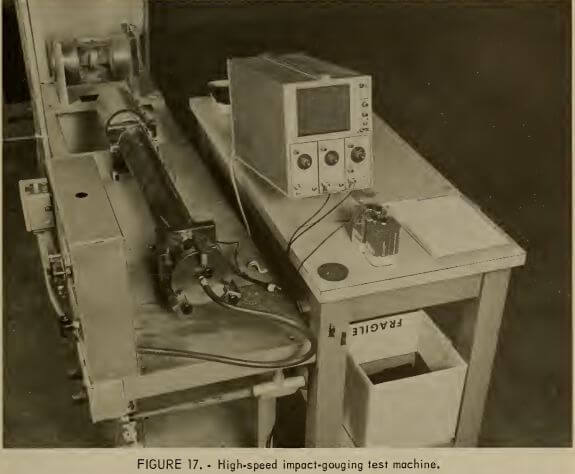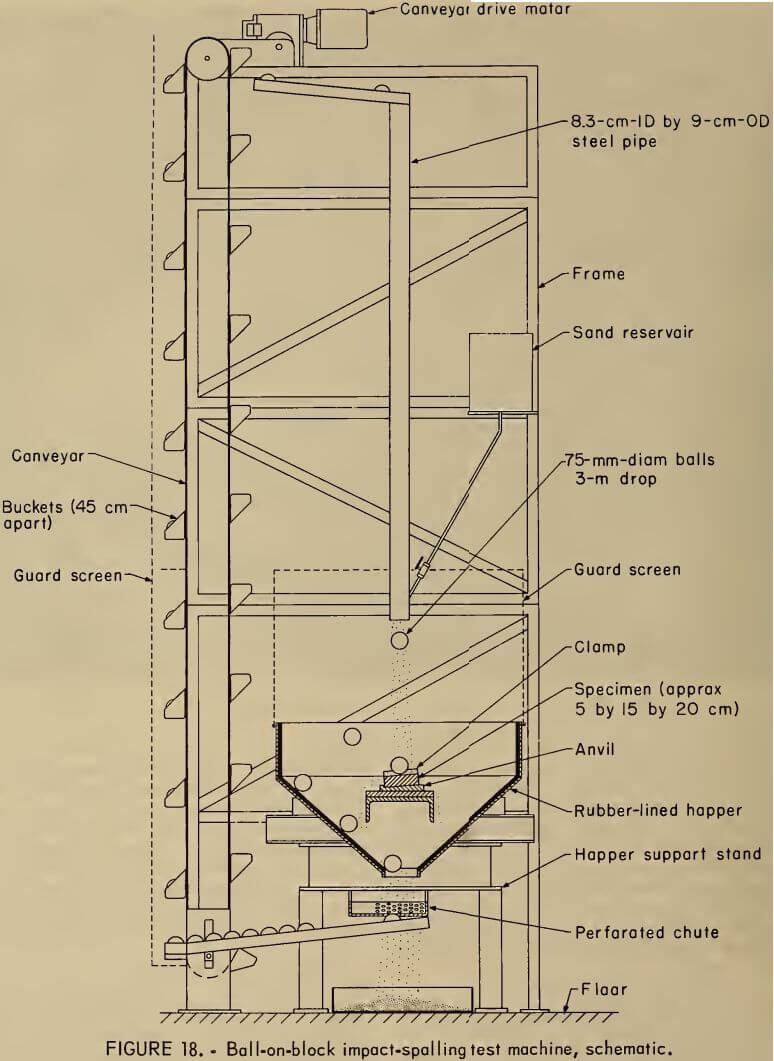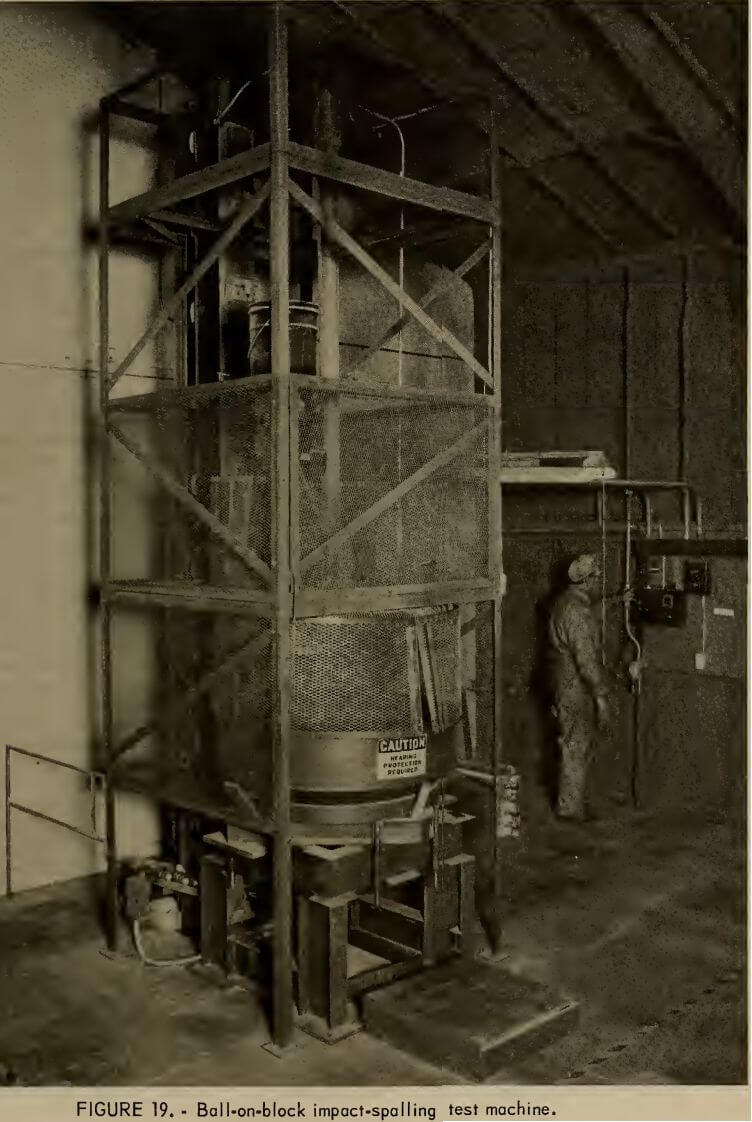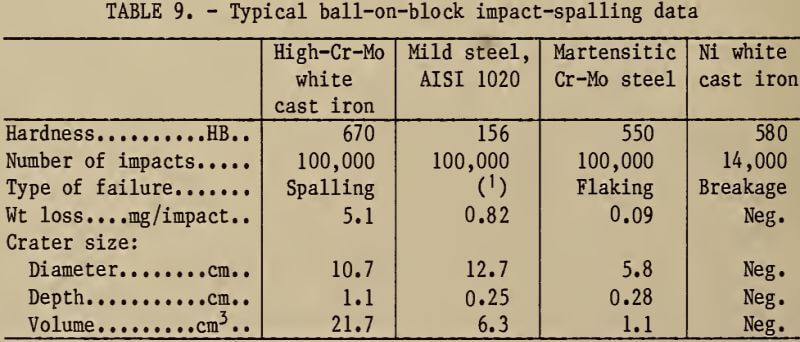Table of Contents
Many types of ore crushing and grinding equipment, such as hammer mills, rod mills, and ball mills, subject wear parts to repetitive impacts. The wear that results from fatigue, spalling, chipping, and fracturing can be more severe than abrasive wear. This is especially true of very hard alloys such as martensitic steels and alloyed white cast irons with their superior abrasion resistance but with a propensity to spall or break after large numbers of impacts.
Neither fracture toughness nor Charpy impact tests have proven useful for predicting behavior of the relatively brittle, wear-resistant materials subjected to repeated impacts.
Ball-on-Block Impact-Spalling Test

A test that simulates the type of wear caused by repetitive impacts is the ball-on-block impact-spalling test. The testing machine drops steel balls repeatedly onto a test block, as described fully by Blickensderfer and Forkner. The impacts are concentrated onto one relatively small area on the test block. Testing machines of similar concept were used previously by Dixon and Durman. Machines of this type have been useful for obtaining laboratory data on the spalling and fracture resistance of materials subjected to repeated impacts.
Ball-on-Block Equipment and Specimen
The machine consists of a steel frame, a conveyor for lifting balls, ramps for transporting balls, and an anvil for supporting a specimen inside a large funnel that collects the rebounding balls, as shown in figures 18 and 19. The commercial steel balls used are 75 mm in diam and weigh about 1.8 kg. From the top of the conveyor, the balls roll into a vertical tube that directs them onto the test block after a fall of 3 m. Silica sand is continuously fed onto the test block in order to more closely simulate the condition in a ball mill wherein ore is present on the liners. The number of impacts is displayed by a counter that is actuated when a ball interrupts a light beam across the lower ramp.

Test blocks are approximately 50 mm thick, 15 cm wide, and 20 cm long. The 15- by 20-cm face is the impact surface. Blocks are surface-ground on the bottom to ensure good contact with the anvil. If the quality of a cast block is questionable, it should be X-rayed first, in order that valuable test time is not spent on inferior materials.

Ball-on-Block Procedure
The test block is clamped securely to the anvil, and safety guards are installed. The balls, normally 12, are placed in the machine. The sand flow and conveyors are turned on. With the conveyor running at a speed of 38 m/min, about 2,000 impacts per hour are delivered to the test block. A block is tested until it breaks or 100,000 impacts are delivered. During the test, the weight loss and size of the developing crater are measured at intervals of 10,000, 20,000, 35,000, 60,000, and 100,000 impacts. During operation, an area within 2 m of the machine is blocked off to prevent injury to personnel because occasionally a ball escapes from the machine with sufficient energy to cause severe injury.
Ball-on-Block Results and Discussion
Four types of failures have been observed, namely, cold flow, flaking, spalling, and breakage. The softer and more ductile steel alloys tend to cold flow and flake. Cold flow describes the movement of bulk metal by plastic deformation and is identified by an impact crater and rounded edges of the block. Flaking describes the formation and subsequent separation from the surface of thin flakes of metal that develop from fatigue. Cold flow and flaking occur together but to differing degrees depending upon the particular alloy.
Spalling and breakage tend to occur on the harder (more wear-resistant) alloys. Spalling describes the separation of pieces of material of about 3- to 6-mm dimensions. A crater develops in the impact region as a consequence of spalling. If a block fractures into two or more major pieces, it is termed breakage. Blocks may or may not spall before breakage occurs, depending upon the composition and heat treatment.
Data showing typical test results are given in table 9.

Ball on Ball Impact Spalling Test
The ball-on-ball impact-spalling test is designed to create large numbers of impacts on test materials in a relatively short time. Designed and constructed by the Bureau, the test is an advance over the earlier ball-on-block drop tests because of at least a twenty-fold increase in testing speed. The test, described in greater detail by Blickensderfer and Tylczak, has proven especially useful for studying the spalling of alloyed white cast irons and for comparing the resistance to breakage of commercial and experimental grinding balls. Because the impacts are distributed randomly over the entire surface of the ball specimen, the entire surface becomes highly stressed under compression.
Ball-on-Ball Equipment and Specimens
Balls are impacted against each other in a manner that provides many impacts in a relatively short time. A ball is dropped 3.5 m onto a column of balls contained in a curved tube, as shown in figure 20. The impact from the dropped ball is transmitted through the column of balls with each successive ball receiving a ball-on-ball impact on each side. The kinetic energy of the first impact is 54 J. The energy of subsequent impacts through the tube decreases until it is about 5 J at the last impact. The energy in the last ball carries it out of the end of the tube onto a ramp where the ball actuates a counter and rolls into a bucket conveyor that carries it to the top of the machine to be dropped again. The machine provides random occasional mixing of the balls as described in reference 45, to give different neighbors to each ball over a period of time.
Two advantages of the design are (1) it produces many impacts quickly on a group of balls, and (2) the impacts are of variable intensity, as found in a real ball mill.
The test balls are 75 mm in diam and weigh about 1.8 kg. Both cast and forged steel balls and cast iron balls have been used. Because many different ball specimens are run simultaneously, they are identified by grinding small flats on their surfaces.
Ball-on-Ball Procedure
To start a test, 22 balls are loaded into the machine. During operation there are typically 18 balls in the tube and 4 in the ramps and in the conveyor buckets. The machine drops about 22 balls per minute. For each ball dropped, 36 impacts are created—two on each ball in the tube except the one dropped and the one leaving the tube. This gives a rate of about 45,000 total impacts per hour in the system. The machine is run unattended. When a ball breaks, the pieces block the tube or ramp and all balls cease to circulate. Although the conveyor continues running, the ball drop count remains fixed on the counter. An area within 2 m of the machine is blocked off during operation to prevent injury to personnel because if a ball escaped from the machine, it could cause severe injury to a person.
Balls are tested until they break or until they spall excessively. Experience showed that balls that have spalled over 150 g do not roll down the ramps; therefore, a ball is removed from the test after it has lost 100 g by spalling. All balls are removed from the tube and weighed at intervals of 5,000 to 20,000 impacts per ball. Accurate accounting of the impacts is kept on each ball. A ball that fails is replaced with either another test ball or a hardened steel filler ball, and the test is continued.
Ball-on-Ball Results and Discussion
Four types of failures have been observed: (1) spalling, pieces of 2 to 5 cm across and up to 1 cm thick, (2) mini-spalling, small deep crescent pits 2 to 4 mm across and 2 to 3 mm deep, (3) flaking, very thin flakes with extreme surface cold work, and (4) breakage, a complete failure of the ball, often by fracturing through the center of the ball.
The type of failure of a ball seems to be dependent on hardness and the means by which the balls were produced. Spalling occurs mainly in cast balls and starts within 50,000 impacts. Minispalling occurs in forged, hard (about HRC 62 to 64) steel balls and does not start until 100,000 or more impacts. Flaking and plastic deformation are the only damage that occur to the softer (less than HRC 40) forged steel balls. The flakes develop after 60,000 or more impacts. Breakage occurs in fully hard (greater than HRC 63) steel balls and unheat- treated cast balls and can occur any time from a few to a few hundred thousand impacts. Additional results are presented by Blickensderfer.

